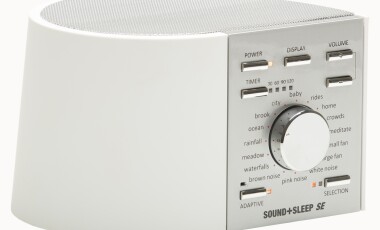Think of bedroom design with a Goldilocks approach. It must be cool, but not cold. It must be dark, but with the ability for soft ambient lighting. And it must be quiet, but sometimes the best way to drown out early morning garbage trucks or heavy-footed neighbors is through more noise, like a sound machine. Designing a bedroom is a delicate balance, but the effort is worth it when the payoff is more and better sleep.
Interior designer Marie Flanigan, a classically trained architect, knows her way around a sleep-optimized bedroom. “After a long day, homeowners should want to retreat to their bedrooms because it is just that – a retreat,” she says. “The design, palette, and function play a huge role in ensuring adequate rest and relaxation.”
Robert Pagano, owner of Sleepline, agrees. “The goal with bedroom design is to create an area that's both functional and visually appealing,” he says. “Keep in mind that different people might prefer different things when it comes down to how they feel most comfortable at night, whether they want privacy, quietness, or good lighting for reading purposes.”
Either way, we all have the same bedroom goal: to get the most restful shuteye as possible. For the most sleep-optimized space, incorporate — or remove — these elements from your bedroom
1. Maximize your bedroom layout

Take note: Which direction does your bedroom’s primary window face? Does bright morning light stream in, or is your bedroom washed in soft afternoon light?
Understanding your natural light situation will help you plan for the appropriate shades, plants, paint colors, and furniture configuration. For instance, if your bed is directly in line with an east-facing window, early morning sunshine may wake you before your circadian rhythm is ready. Rearrange the bed to face another direction, if possible, or invest in blackout shades if not.
If you haven’t touched your bedroom furniture in a good minute, it might be time to assess, particularly when it comes to the quality of your mattress. Put that first on your redesign list and when your chosen mattress comes in, take some time to really consider where your bed should go.
2. Set up space to block out noise
As for sound, pay attention to noises that regularly wake you up at inopportune times. Are you routinely awoken by clamoring construction workers or your neighbor’s stampeding kids?
A sound machine by your nightstand can be a worthwhile investment, or a set of earplugs may do the trick. Just be sure that you can hear your alarm over whatever noise-blocking method you choose.
3. Routinely take inventory of clutter and dust — and sweep it away
Whether intentional or not — most likely not — give any space a couple months (or even a couple days) and piles of who-knows-what will inevitably appear, which could disrupt the calming vibes you’re aiming for. Flanigan suggests routinely taking inventory of the clutter in your bedroom.
Ask yourself what is functioning and what isn’t, then cull the items that aren’t serving a purpose. “When your bedroom is cluttered, it won’t be calming,” says Flanigan. You also don’t want the clutter to be a hotspot for dust and dust mites. Prone to allergy symptoms? Save this cleaning checklist and stick to it. Your sleep will thank you.
4. Stick to a soothing color theme — whatever that means to you
There’s no one-size-fits-all for a relaxing bedroom design, including wall color. “Any color that makes you feel calm will lead to good sleep,” says Flanigan. If a neutral color scheme helps you unwind, thread those colors into your room’s décor. If you want a space that mimics nighttime, veer towards dark and moody paint colors.
However, if you don’t feel any specific way, designers do say certain colors can promote different moods. “Colors with a cool temperature, such as those slanted toward the color wheel from purple-blue or blue-green, have been linked to feelings of calmness and relaxation, which is what you want right before bed,” Pagano says.
“Warm colors — those that contain yellow or red as their primary components, such as orange and red, can also be calming,” says Pagano. “But because they focus on creating warmth in an environment rather than promoting relaxation they may not be ideal for someone looking to sleep better at night.”
Ultimately, choose a paint color that’s relaxing to you, whether that’s a tranquil neutral or a rich, deep tone. The one color to maybe stay away from? “Yellow,” says Pagano, “which could give people the energy to stay awake longer.”
5. Embrace the dark (and dim) side

When it comes to getting good sleep, the darker your bedroom, the better, and blackout window treatments are the ticket to blocking out bright morning sun. “There are plenty of beautiful shade options that include blackout capabilities so that you no longer sacrifice style for function,” says Flanigan.
In addition to sunshine, pay attention to the other sources of light in your bedroom. Set the tone with ambient lighting, such as a beautiful chandelier or bedside table lamps that you can dim. “Throughout the day, the amount of light we need changes significantly and having overhead lighting on a dimmer is a great way to match your room to your needs and mood,” says Flanigan. If your overhead light doesn’t come with a dimmer, avoid relying on it at night.
6. Include tactile touches for the senses
In preparation for sleep, our bodies naturally drop an internal degree or two, so cozy up. Rugs, quality linens, and welcoming pillows can help alleviate that chill. Plus, a room and bed that are comfortable to rest in can get you primed for sleep.
Be sure that your bed is outfitted with a comfortable mattress and sheets that feel good to you, to set you up for great nights. “Good linens and a nice mattress both lend themselves to comfortable, quality sleep,” says Flanigan.
7. Bring in a bit of nature as a relaxation reminder
“The mere presence of plants has been proven to help humans manage stress and reclaim inner peace,” says Bryana Sortino, co-founder and COO of Horti, an indoor-plant subscription service. Manage stress and reclaim inner peace? Consider us sold.
If your bedroom has bright indirect light, Sortino suggests a fern or plants from the Calathea family, like Makayona. For bedrooms with direct sunlight, she recommends a snake plant, even though it’s often sold as a low-light plant. “They have learned to adapt beautifully to a lot of varied environments and can sustain low light — technically they just die slower than other plants — but are happiest in direct sun,” she says.

Like people, plants function best at an ideal temperature. The ones Sortino mentioned tend to thrive between 60 to 70 degrees Fahrenheit, which is also the magic number to help people sleep (give or take a few degrees). In fact, research says temperature is one of the most important factors to getting high-quality sleep.
Whether you're motivated to keep your plant thriving or your sleep space optimized, you can now do both. Depending on the season and whatever clamor may or may not be happening outside your bedroom, crack a window for fresh air, or turn down the thermostat a notch or two.
8. Create a space for powering down
Here’s yet another reminder to be mindful of how you use electronics in the bedroom. Keeping your phone nearby for emergency purposes or sleep-tracking capabilities is fine, but doom-scrolling before bed is not.
If you cannot resist the temptation to check social media, make a nightstand that lets you tuck away devices or keep your phone in another room.
9. Balance your pets’ presence in the bedroom
As much as you love your furry friend, sleeping with pets in the bed is likely disrupting your Zzz’s. Their snoring, bed-hogging, whimpering, or twitchy dreams about chasing squirrels could be waking you up in the middle of the night.
Remember, pets’ sleeping patterns are different from ours, so for a better night’s sleep, it’s best to kindly evict anyone with fur and four legs from your bedroom. Of course, there are exceptions to every rule, like pets (and people!) with separation anxiety and service animals.
10. Change what isn’t working
If you’ve achieved a dark, quiet, cool room, but quality sleep isn’t coming, you may need to make more substantive changes, including a new bed or other big changes.
Before embarking on an overhaul, take note of what you need, and what you have the budget for. Save for items that you think will make a big difference in your sleep and take your time to gauge how each change improves your sleep, so that you’re not overwhelmed by changes all at once.
“Ensuring good sleep is an investment, but it doesn’t mean that the items have to be expensive,” says Flanigan. Before dropping serious dollars on a bedroom redesign, first try easy and inexpensive improvements, like painting or rearranging, to see if it improves your sleep quality.
Creating a sleep-optimized bedroom takes patience. It doesn’t have to, and most likely won’t, feel perfect right away. You may need to reorganize your room a few times or experiment through the seasons, but just like Goldilocks, you’ll find your perfect balance and sleep will feel just right in your bedroom.
[Note: If you buy something using a link on our site, we may earn a commission.]














